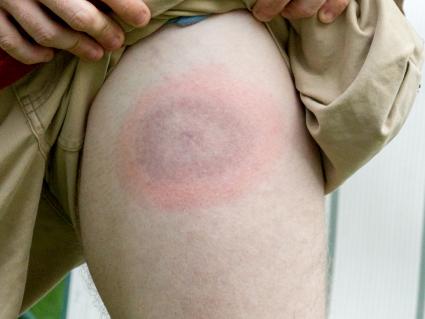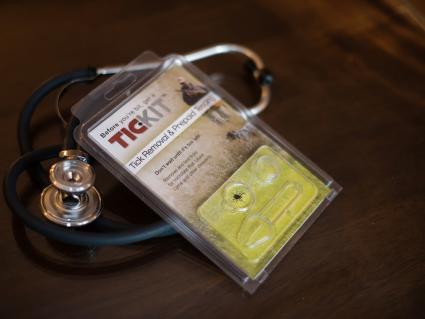Myth: Bullseye Rash is Always Present in Lyme Disease

Many people believe that the bullseye rash, also known as erythema migrans (EM), is necessary for a Lyme disease diagnosis. While a bullseye rash is indeed clinically diagnostic, its absence cannot rule out either acute or chronic Lyme disease. However, a non-bullseye rash is more common...
Non-Bullseye Rashes Are More Common:
- The most common type of rash from a tick bite is a non-specific, solid-colored pink rash, occurring more frequently than the bullseye rash. Still, this may occur in as little as 50% of cases of Lyme. [1].
- Only about 33% of patients with Chronic Lyme Disease recalled having a bullseye rash, and 42% remembered a tick bite [2].
- EM rash is only present in about 70% of early cases of Lyme disease [3]. Approximately 20-30% of patients with Early Lyme Disease will not present with EM.
Beware of Co-Infections:
- There are several other infections that ticks can transmit. These are known as “co-infections”, such as anaplasmosis and babesiosis. These infections can mimic Lyme disease symptoms but won't cause a bullseye rash.
- Relying solely on the absence of a bullseye rash to rule out Lyme disease can result in missed diagnoses of co-infections.
Diagnosing Without a Bullseye Rash:
- If a bullseye rash isn't present, consider other factors:
- Exposure to tick-endemic areas. Remember that cases of tick borne illness have been reported in all 50 states.
- Hobbies or work that involves the outdoors or risk for exposure, such as farming, landscaping, gardening, Veterinary, horseback riding, hunting, hiking, etc.
- Owning pets such as dogs, cats, horses
- Presence of common Lyme disease symptoms such as fatigue, fevers, chills, joint pain, muscle aches, abnormal sweats, swollen lymph nodes, headache
- Use positive laboratory findings as additional supportive evidence
Don't solely rely on the presence or absence of a bullseye rash for a Lyme disease diagnosis. Consider other factors and symptoms to ensure accurate diagnosis and treatment.
Resources:
1 Smith RP, Schoen RT, Rahn DW, et al. Clinical characteristics and treatment outcome of early Lyme disease in patients with microbiologically confirmed erythema migrans. Ann Intern Med 2002;136:421-8.
2 Johnson, L., Shapiro, M., Stricker, R. B., Vendrow, J., Haddock, J., & Needell, D. (2020, October). Antibiotic treatment response in chronic lyme disease: why do some patients improve while others do not?. In Healthcare (Vol. 8, No. 4, p. 383). MDPI.
3 Schwartz, A. M., Hinckley, A. F., Mead, P. S., Hook, S. A., & Kugeler, K. J. (2017). Surveillance for lyme disease—United States, 2008–2015. MMWR Surveillance Summaries, 66(22), 1
About Kaitlin Surber,, PA-CRelated Blog Posts

Lyme Myth: Everyone with Lyme or a Tickborne Illness Needs to Avoid all Gluten and Dairy
Truth/Fact: Gluten sensitivities are extremely common, in part due to the pesticides used on conventionally grown wheat (called glyphosate or Roundup). This is also found on GMO crops such as corn and soy and can irritate the gut lining, weakening our immune system and having other impacts on our overall wellness. While many common food sensitivity tests are ineffective, an elimination diet along…Read the Post

An Interview with Dr. Stram: How Effective are the Current Conventional Treatments for Lyme Disease?
In this interview, we asked the founder of the Stram Center, Dr. Ronald Stram, how effective current antibiotic protocols are in regard to Lyme disease treatment. Dr. Stram has devoted his career to those suffering from chronic illnesses, specifically tick-borne diseases. Since 2003, the Stram Center has served nearly 10,000 patients suffering from Lyme disease all across the globe. Dr. Stram…Read the Post

Foods to Help Fight Lyme
Here are some food suggestions for fighting Lyme Disease, and what foods to avoid -- taken directly from Dr. Stram’s PowerPoint presentation to Core Life Eatery’s sold out audience on June 13th in Vestal, NY. We hope this information will help you in your quest to overcome Lyme!Read the Post

Herbal Support For Lyme Disease
Lyme disease a bacterial infection caused by Borrelia Burgdorgeri and in late stages, it can be difficult to treat. There is evidence that the Borrelia bacteria persists in tissues and can shift its form or shape in unfavorable host conditions, including a round body or cyst shap1.Different types of antibiotics and herbs have been studied to find the most effective agent that can…Read the Post

How to Recognize and Prevent Lyme Disease
This month is Lyme disease awareness month. As the number of cases continue to increase year after year, one must be knowledgeable about how to recognize and prevent this elusive and challenging disease. Lyme disease is a spirochetal bacterial infection transmitted by deer ticks. In the late 1970s in Lyme, Connecticut, a group of children started having symptoms that included rashes, fevers,…Read the Post
Related Services

Lyme Disease
Lyme Disease Diagnosis and Treatment in Delmar NY and Burlington VT offices At the Stram Center we vow to continue our education on Lyme Disease research, stay up to date on the most effective testing and all the safe available therapies. Moreover, our years of experience in treating patients according to the whole person-integrative medicine approach allows us the most effective way to care…Lyme Disease





















